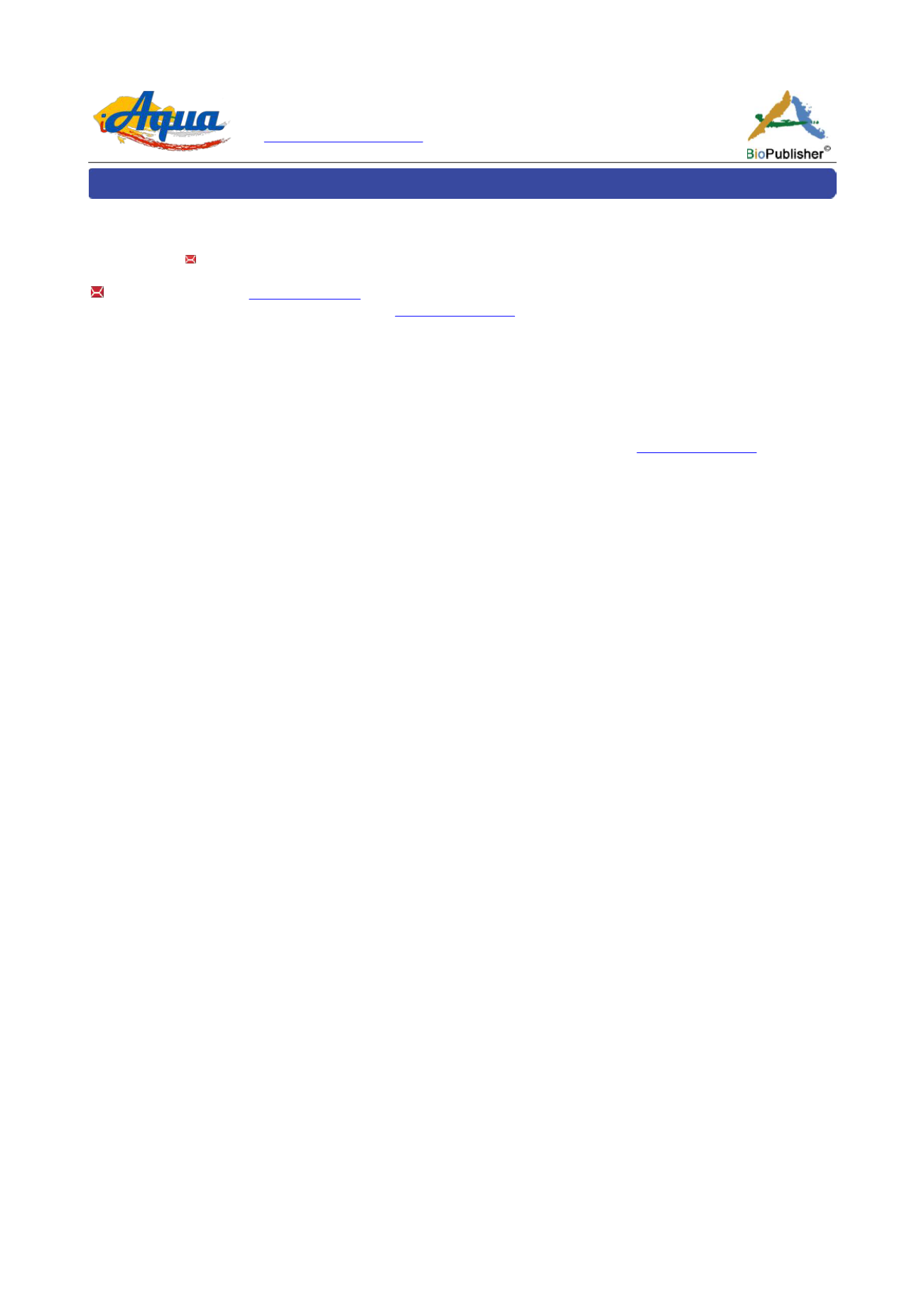
International Journal of Aquaculture, 2017, Vol.7, No.17, 112-121
112
Research Article
Open Access
Effect of Different Doses of Rabbit Manure on the Abundance, Growth Rate and
Production of Zooplankton in Plurispecific System for Fish Larvae Feeding
Richard Adande , Mouhamadou Nourou Dine Liady, Edmond Sossoukpe, Emile Didier Fiogbe
University of Abomey-Calavi (UAC), Faculty of Science and Techniques (FAST), Laboratory of Research on the Wetlands (LRW), 01 BP 526, Cotonou, Benin
Corresponding author Email:
International Journal of Aquaculture, 2017, Vol. 7, No.17 doi:
Received: 20 Sep., 2017
Accepted: 12 Oct., 2017
Published: 27 Oct., 2017
Copyright © 2017
Adande et al., This is an open access article published under the terms of the Creative Commons Attribution License, which permits
unrestricted use, distribution, and reproduction in any medium, provided the original work is properly cited.
Preferred citation for this article
:
Adande R., Liady M.N. D., Sossoukpe E., and Fiogbe E.D., 2017, Effect of different doses of rabbit manure on the abundance, growth rate and production of
zooplankton in plurispecific system for fish larvae feeding, International Journal of Aquaculture, 7(17): 112-121 (doi:
Abstract
In order to determine the optimal dose of rabbit manure for plurispecific production of fresh water zooplankton in
controlled area, the effects of six different doses of dry rabbit manure (T
1
= 300 g/m
3
, T
2
= 600 g/m
3
, T
3
= 900 g/m
3
, T
4
= 1200 g/m
3
,
T
5
= 1500 g/m
3
, T
0
= 0g/m
3
) on physico-chemical and biological parameters of areas were monitored for 27 days in cultures realized
in plastic buckets of 80 L capacity each. Manures are from rabbits fed with diet previously revealed favorable to their growth, and is
made of 2% of dried cassava, 30% of maize bran, 10% of palmist cake, 10% of soya cake, 5% of cotton cake, 2% of shell, 10% of
malt, 5% of beer yeast, 10% of
Panicum maximum
and 1% of salt. Six days after fertilization, buckets were seeded with zooplankton
by 26 individuals per liter (ind/L). Results obtained show that the supply of rabbit manure has improved chemical properties and
microalgae production (phytoplankton) with treatments T
1
, T
2
, T
3
, T
4
and T
5
. Optimal conditions of zooplankton production through
phytoplankton are obtained with doses in T
2
and T
4
which present the best specific growth rate. The daily production through the
highest phytoplankton biomass (chlorophyll-a) has been obtained with dose in T
5
. Thus, doses 600 g/m
3
and 1200 g/m
3
of rabbit
manure may be considered optimal for a plurispecific production of fresh water zooplankton. It was noted that Rotifers were
predominant in abundance in almost the different culture areas.
Keywords
Rabbit manure; Optimal dose; Zooplankton; Plurispecific production
1 Background
The natural feed appreciated by fish larvae is essentially made of zooplankton and artificial dry feed are not
always appropriated to this premature stage (Arimoro, 2005). Consequently, zooplankton such as cladocerans,
copepods and rotifers are used for larval rearing by many researchers in controlled area (Awaïss et al., 1992).
Artemia (live food) is the most used for certain marine species whose hatching, development and growth were
realized in pond (Agadjihouèdé et al., 2011). Nevertheless, it remains less effective in fresh water fish larvae.
Artemia as larvae food is inaccessible to rural fish farmers (Fiogbe et al., 2003). Indeed, its use doesn’t always
give good zootechnical performances to fresh water fishes. Zooplankton production in controlled area is carried
out in many studies, by the way of phytoplankton production using different types of fertilizer (chemical, organic
genuine vegetal or animal) (Adande et al., 2015). Chemical fertilizers (minerals) are the former used for
phytoplankton production for the purpose of zooplankton production (Boyd et al., 2008) while organic fertilizers
genuine vegetal or animal are the second used (Dalme et al., 2011). Between these two categories of fertilizer, the
first type is dangerous to the environment and also expensive while the second type is less expensive and does not
present any risk for the environment (Agadjihouèdé et al., 2011; Adande et al., 2017). These findings justify
nowadays the easy use of organic fertilizers genuine animal such as cow and poultry manure (Agadjihouèdé et al.,
2010), and pig dung (Ekelemu et al., 2011), in zooplankton production. The quantities of these organic fertilizers
used influence too much the productivity of phytoplankton and indirectly of zooplankton and; according to the
literature; there is an optimal dose for which a maximum production of zooplankton could be obtained. Indeed,
different doses of manure have been tested in experiments on zooplankton production by many authors. Saint-Jean
et al. (1994), for the production of Moina micrura used 0.05 g of poultry manure per liter of water; Agadjihouèdé
et al. (2010) used in aquarium designed for zooplankton production 0.6 g of poultry manure per liter of water; by
the same way, Akodogbo et al. (2014) used 0.3 g of pig dung per liter of water in plastic buckets during a


